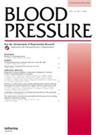Effect of angiotensin receptor blockers on blood pressure and renal function in patients with concomitant hypertension and chronic kidney disease: a systematic review and meta-analysis
IF 2.3
4区 医学
Q2 PERIPHERAL VASCULAR DISEASE
引用次数: 10
Abstract
Abstract Objective: Angiotensin receptor blockers (ARB) are among the recommended first-line treatment options in patients with hypertension and chronic kidney disease (CKD). This meta-analysis evaluated the effect of ARB on blood pressure (BP) and renal function in patients with concomitant hypertension and CKD with or without diabetes. Methods: Literature search was performed in PubMed/MEDLINE, EMBASE and BIOSIS to identify parallel-group, randomized controlled trials (≥8 weeks) reporting the effects of ARB on office systolic/diastolic BP (SBP/DBP), estimated glomerular filtration rate (eGFR), serum creatinine (SCr), creatinine clearance (CrCl) or proteinuria in adults with hypertension and CKD. Mean difference (MD, generic inverse variance) with 95% confidence intervals (CIs) was used to report an outcome. Results: Among the 24 studies identified, 19 evaluated ARB as monotherapy, 4 evaluated ARB as combination therapy and one evaluated ARB both as monotherapy and combination therapy. Median (range) duration of the studies was 12 (1.84–54.0) months. ARB monotherapy significantly (p < 0.01) reduced BP (treatment ≥1 year: SBP [MD: −14.84 mmHg; 95% CI: −17.82 to −11.85]/DBP [−10.27 mmHg; −12.26 to −8.27]) and proteinuria (≥1 year [−0.90 g/L; −1.22 to −0.59]). Results were consistent for combination therapy. In these studies, non-significant changes were observed for eGFR, CrCl and SCr. The impact of SBP changes on eGFR was not significant; however, studies were of a relatively short duration. Conclusion: ARB had a favorable impact on BP and renal parameters such as proteinuria with monotherapy as well as with combination therapy, highlighting their potential benefits in patients with hypertension and CKD. During the short follow-up of these studies, no significant change in eGFR was observed.血管紧张素受体阻滞剂对合并高血压和慢性肾脏疾病患者血压和肾功能的影响:系统综述和荟萃分析
摘要目的:血管紧张素受体阻滞剂(ARB)是高血压和慢性肾脏病(CKD)患者推荐的一线治疗方案之一。这项荟萃分析评估了ARB对伴有或不伴有糖尿病的高血压和CKD患者的血压(BP)和肾功能的影响。方法:在PubMed/MEDLINE、EMBASE和BIOSIS中进行文献检索,以确定平行组、随机对照试验(≥8周),报告ARB对高血压和CKD成人办公室收缩压/舒张压(SBP/DBP)、估计肾小球滤过率(eGFR)、血清肌酸酐(SCr)、肌酸酐清除率(CrCl)或蛋白尿的影响。使用95%置信区间(CI)的平均差(MD,一般逆方差)来报告结果。结果:在确定的24项研究中,19项将ARB评估为单药治疗,4项评估为联合治疗,1项同时评估为单一治疗和联合治疗。研究的中位(范围)持续时间为12个月(1.84–54.0)。ARB单药治疗显著(p < 0.01)降低血压(治疗≥1年:收缩压[MD:-14.84 mmHg;95%置信区间:−17.82至−11.85]/DBP[−10.27 mmHg;−12.26至−8.27])和蛋白尿(≥1年[-0.90 g/L;−1.22至-0.59])。联合治疗的结果是一致的。在这些研究中,观察到eGFR、CrCl和SCr的无显著变化。SBP变化对eGFR的影响并不显著;然而,研究的持续时间相对较短。结论:ARB单药和联合治疗对血压和蛋白尿等肾脏参数有良好影响,突出了其对高血压和CKD患者的潜在益处。在这些研究的短期随访中,没有观察到eGFR的显著变化。
本文章由计算机程序翻译,如有差异,请以英文原文为准。
求助全文
约1分钟内获得全文
求助全文
来源期刊

Blood Pressure
医学-外周血管病
CiteScore
3.00
自引率
5.60%
发文量
41
审稿时长
6-12 weeks
期刊介绍:
For outstanding coverage of the latest advances in hypertension research, turn to Blood Pressure, a primary source for authoritative and timely information on all aspects of hypertension research and management.
Features include:
• Physiology and pathophysiology of blood pressure regulation
• Primary and secondary hypertension
• Cerebrovascular and cardiovascular complications of hypertension
• Detection, treatment and follow-up of hypertension
• Non pharmacological and pharmacological management
• Large outcome trials in hypertension.
 求助内容:
求助内容: 应助结果提醒方式:
应助结果提醒方式:


